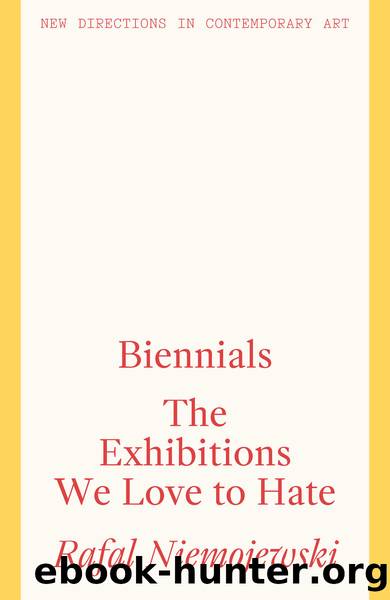Biennials: The Exhibitions We Love to Hate by Niemojewski Rafal;

Author:Niemojewski, Rafal;
Language: eng
Format: epub
Publisher: Lund Humphries
Published: 2021-06-15T00:00:00+00:00
Fig.8 Zadok Ben-David, Blackfield, 2008
The innocuous concept of the following edition in 2011, Open House, described by its curators as âa gesture of hospitality and good willâ and âan opportunity to reflect, negotiate, and exchangeâ, all-too-conveniently resonated both with Richard Floridaâs creative class and the organizersâ own earlier slogans advertising the âRenaissance Cityâ. Regrettably, this edition is also remembered for the censorship of Simon Fujiwaraâs work Welcome to the Hotel Munber (2008â10). This immersive installation recreated a Spanish hotel bar run by the artistâs parents on the Costa Brava during the 1970s. Fujiwara hid within his work references to gay pornographic magazines and erotic fiction, as a reflection upon the repressive nature of General Francoâs military dictatorship. Apparently oblivious to the irony of censuring a work about censorship, the Singapore authorities stripped the installation of the homoerotic elements, despite their being central to Fujiwaraâs conception. The artwork was also closed to the public for the majority of the Biennale, drawing wide and perhaps unwanted media attention.
As the local authorities and opportunity-seeking businesses turned their attention to new cultural projects â the regeneration of Gillman Barracks (a former army site dating back to the 1920s) into a vibrant art quarter inaugurated in 2012, the launch of Singapore Art Week in 2013, and the opening of the new National Art Gallery in 2015 in two downtown buildings that formerly hosted the Supreme Court and City Hall â the spotlight was diffused and the biennial began to enjoy less scrutiny. This in turn enabled more discursive and experimental approaches to emerge. The 2013 edition adopted a bold new collaborative curatorial structure comprising 20 curators with distinct local knowledge of particular art scenes in Southeast Asia. The Singapore Biennale was no longer primarily about Singapore, instead tapping into different curatorial perspectives latent within the region.
This expanded regional focus continued through the following two editions: An Atlas of Mirrors in 2016 and Every Step in the Right Direction in 2019. The latter was curated by Patrick Flores, a scholar of Southeast-Asian art, whose curatorial statement presents an event whose response to a âtroubledâ global situation placed its âfaith squarely in the potential of art (and its understanding) to rework the worldâ.22 In the symposium accompanying this edition, Flores further pondered âhow sensible form can disrupt this hegemonic rhythmâ, anticipating one of the main themes of the conference: an examination of âThe Geopoetic and the Ethicalâ. This explored âthe Biennialâs aspiration to re-world through form and to inspire thoughtful and generous sympathy for urgent actionâ, specifically engaging with âthe potential of places to give rise to transformations within and beyond themselves ⦠[which can become] a form of resistance against hegemonic social formationâ.23 The newfound clarity, or at least directness, articulated in these later editions might be said to echo the revolutionary drive, hope and belief found in Havanaâs earlier years â the similarity in language and wording is striking.
If Havanaâs initial prototype of the oppositional biennial produced a symbol of cultural openness â by definition
Download
This site does not store any files on its server. We only index and link to content provided by other sites. Please contact the content providers to delete copyright contents if any and email us, we'll remove relevant links or contents immediately.
Cecilia; Or, Memoirs of an Heiress — Volume 1 by Fanny Burney(31351)
Cecilia; Or, Memoirs of an Heiress — Volume 3 by Fanny Burney(30949)
Cecilia; Or, Memoirs of an Heiress — Volume 2 by Fanny Burney(30907)
The Great Music City by Andrea Baker(21572)
We're Going to Need More Wine by Gabrielle Union(18086)
Bombshells: Glamour Girls of a Lifetime by Sullivan Steve(13119)
Pimp by Iceberg Slim(12947)
All the Missing Girls by Megan Miranda(12775)
Fifty Shades Freed by E L James(12463)
Talking to Strangers by Malcolm Gladwell(11908)
Norse Mythology by Gaiman Neil(11901)
Crazy Rich Asians by Kevin Kwan(8372)
Mindhunter: Inside the FBI's Elite Serial Crime Unit by John E. Douglas & Mark Olshaker(7850)
The Lost Art of Listening by Michael P. Nichols(6484)
Enlightenment Now: The Case for Reason, Science, Humanism, and Progress by Steven Pinker(6414)
Bad Blood by John Carreyrou(5782)
The Four Agreements by Don Miguel Ruiz(5532)
Weapons of Math Destruction by Cathy O'Neil(5046)
We Need to Talk by Celeste Headlee(4881)
